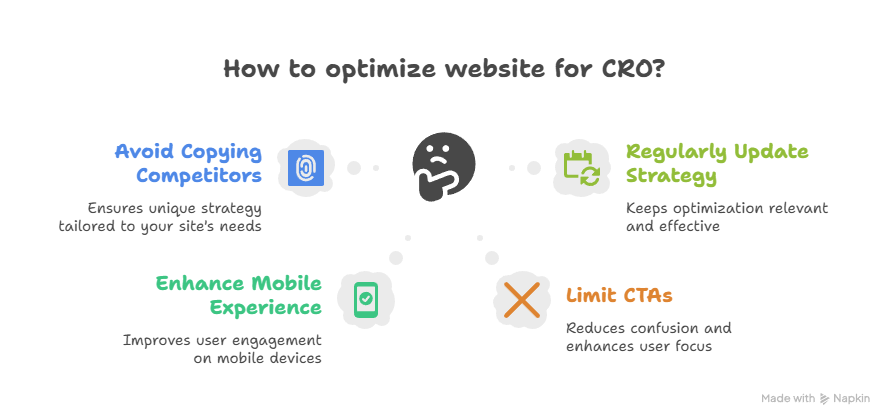If you run a B2B IT service website, you already know that visitors don’t usually buy on the first visit. They explore, compare, and take time to decide. That’s where CRO (Conversion Rate Optimization) comes in.
CRO is the process of improving your website so that more visitors take the action you want, like filling out a form, booking a call, or asking for a quote. For B2B IT companies, it’s not about quick sales. It’s about building trust and turning visitors into qualified leads.
In this blog, we’ll look at some of the CRO best practices that help IT service websites improve engagement, trust, and conversion rates, without making the site feel pushy or complicated.
What Makes CRO Different for B2B IT Service Websites
CRO for IT websites is not the same as for eCommerce or consumer products. The audience is different, they’re decision-makers, managers, or business owners. They want proof, not promos.
B2B conversion rate optimization focuses on building long-term trust and showing expertise. The goal is to help visitors understand your value and make them confident enough to reach out. 68% of B2B buyers research online before contacting a sales rep
Challenges like longer decision-making cycles, technical offerings, and multiple stakeholders make the process slower. That’s why traditional CRO tricks like pop-ups or countdown timers don’t work here. B2B audiences value credibility and logic over urgency and discounts.
Establish a Clear and Strong Value Proposition
Your value proposition tells visitors why they should choose your company. It should answer one question: “What makes your IT service better or different?”
A strong message highlights your expertise, reliability, and business outcomes. For example:
“Arista helps IT companies grow faster with high-performance websites and data-driven optimization.”
Use clear headlines, short sentences, and bullet points to show what you offer. Avoid buzzwords and focus on what the client will get, more leads, better speed, or higher ROI. When visitors understand your value fast, they’re more likely to take the next step.
Visitors should find what they need without getting lost. A confusing website kills conversions fast.
Keep your site structure simple. Use clear menus like “Services,” “Industries,” “Case Studies,” and “Contact.” Make sure internal links guide visitors from general pages to more specific ones. Each page should have a clear purpose in the user journey, from learning about your company to booking a consultation.
Remember, a smooth experience builds confidence. If users can navigate easily, they’ll trust your brand more.
Improve Landing Pages and CTAs
Your landing pages are where conversions actually happen. Each page should focus on one main goal, for example, getting visitors to book a free strategy call or download a whitepaper.
Keep your CTAs (Calls to Action) simple and benefit-driven. Instead of “Submit,” try “Get My Free Audit” or “Schedule a Quick Call.” These sound more human and action-focused.
Forms should be short and easy to fill out, name, email, and maybe one business-related question. Long or complicated forms can turn people away. A clear design and a strong CTA can boost conversions instantly.
Build Trust and Credibility
Trust is everything in B2B. Your website must look and feel reliable.
Add client testimonials, case studies, and certifications that show real results. For example, “Increased conversions by 45% for a cloud services company.” That kind of data builds trust quickly.
You can also include real team photos and behind-the-scenes images. People trust brands that feel human and transparent. Sharing your story makes your IT business feel more approachable and genuine.
Use Data and A/B Testing to Drive Decisions
Good CRO is never about guessing. It’s about testing.
Keep an eye on data like your conversion rate, bounce rate, and time on page. If people leave a page quickly, something’s not working, maybe the headline, layout, or CTA.
Run A/B tests where you compare two versions of a page. Change one thing at a time, like the color of a button or the length of a headline, and see which performs better. Over time, these small changes can lead to big improvements in conversion optimization.
Use tools like Google Analytics, Hotjar, or Crazy Egg to see what users do on your site. Let the data guide your next move.
Focus on Page Speed and Mobile Optimization
Slow websites lose visitors, it’s that simple.
If your site takes more than a few seconds to load, people won’t wait. A fast, smooth website improves user experience and helps boost conversions.
Make sure your site is mobile-friendly too. Many executives and decision-makers browse on their phones while traveling or between meetings. Test your site on multiple devices to ensure it loads fast everywhere.
Tools like PageSpeed Insights or GTmetrix can help you track performance and find what’s slowing things down. In CRO, speed equals trust, and trust equals conversions.
Personalize Content and User Experience
Every visitor is different. Personalization makes your website feel more relevant and helpful.
You can show personalized content based on visitor location, company size, or browsing behavior. For example, a visitor from a SaaS company can see case studies related to SaaS, while a manufacturing client sees something more relevant to them.
Even small touches, like using dynamic headlines or showing industry-specific testimonials, can make users feel seen and understood. And when people feel understood, they’re more likely to convert.
Align CRO with SEO and Content Strategy
CRO and SEO are like two sides of the same coin. SEO brings visitors to your website; CRO makes them stay and take action.
Make sure your pages are optimized for both search and conversion. That means writing clear, keyword-rich content while also focusing on usability and engagement.
Content marketing also supports CRO. Blog posts, whitepapers, and case studies can nurture leads and guide them through the funnel. When your SEO and CRO work together, you get steady traffic and better conversion rates.
Common CRO Mistakes to Avoid

Even the best IT companies make mistakes when optimizing their websites. Here are a few to avoid:
- Copying competitors without testing your own site’s needs. What works for them might not work for you.
- Ignoring mobile experience, many B2B sites still don’t perform well on phones.
- Overusing CTAs, too many buttons or messages can confuse visitors.
- Not revisiting your CRO strategy, optimization is not a one-time job. Keep testing, learning, and updating.
Avoiding these errors keeps your strategy clean and effective.
Conclusion
CRO isn’t just about more clicks, it’s about better engagement, stronger trust, and more qualified leads. For B2B IT service websites, focusing on user experience and clarity can make a massive difference.
By following these CRO best practices, your website can guide visitors smoothly from interest to action. Keep testing, learning, and improving. Even small changes, like rewriting a headline or simplifying a form, can lead to big growth.
And if you want expert support to optimize your user journey the right way, Arista Systems offers dedicated CRO services that help you improve conversions, refine UX, and turn your website into a consistent lead-generation engine.
So, here’s your challenge for the week: audit your website or try one new CRO tactic. Maybe it’s improving a landing page, adding a new case study, or testing a new CTA. Whatever you choose, make sure it helps visitors trust you more, because trust is what truly converts in B2B.
FAQs
What is a CRO checklist?
A CRO checklist is a step by step list of tasks used to optimize a website for higher conversions. It includes actions like improving page speed, refining CTAs, analyzing user behavior, testing landing pages, and removing friction points to increase the percentage of visitors who take action.
Is 30% conversion rate good?
A 30 percent conversion rate is considered excellent for most industries. Average conversion rates usually range between 2 percent and 10 percent, depending on the niche, traffic quality, and offer strength. Anything above 20 percent is typically seen as high performing.
How to be an effective CRO?
To be effective in CRO, you need to understand user psychology, analyze data, identify drop off points, run A B tests, optimize landing pages, and continuously refine the user journey. Consistency, experimentation, and data driven decisions are key.
What are CRO strategies?
CRO strategies include improving website speed, optimizing landing pages, enhancing user experience, refining CTAs, using heatmaps and analytics, testing different versions of pages, personalizing content, and reducing checkout friction. These strategies help turn more visitors into customers.


